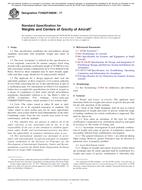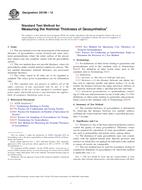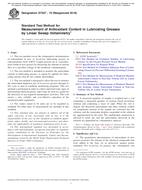1.1 These test methods cover laboratory compaction methods used to determine the relationship between water content and dry unit weight of soils (compaction curve) compacted in a 4- or 6-in. (101.6 or 152.4 mm) diameter mold with a 10-lbf. (44.5-N) rammer dropped from a height of 18 in. (457 mm) producing a compactive effort of 56,000 ft-lbf/ft3 (2,700 kN-m/m³).
Note 1 – Soils and soil-aggregate mixtures should be regarded as natural occurring fine- or coarse-grained soils or composites or mixtures of natural soils, or mixtures of natural and processed soils or aggregates such as silt, gravel, or crushed rock.
Note 2 – The equipment and procedures are the same as proposed by the U.S. Corps of Engineers in 1945. The modified effort test (see 3.2.2) is sometimes referred to as the Modified Proctor Compaction Test.
1.2 These test methods apply only to soils (materials) that have 30 % or less by mass of their particles retained on the 3/4-in. (19.0-mm) sieve.
Note 3 – For relationships between unit weights and water contents of soils with 30 % or less by weight of material retained on the 3/4-in. (19.0-mm) sieve to unit weights and water contents of the fraction passing the 3/4-in. (19.0-mm) sieve, see Practice D 4718.
1.3 Three alternative methods are provided. The method used shall be as indicated in the specification for the material being tested. If no method is specified, the choice should be based on the material gradation.
1.3.1 Method A:
1.3.1.1 Mold – 4-in. (101.6-mm) diameter.
1.3.1.2 Material – Passing No. 4 (4.75-mm) sieve.
1.3.1.3 Layers – Five.
1.3.1.4 Blows per layer – 25.
1.3.1.5 Use – May be used if 20 % or less by mass of the material is retained on the No. 4 (4.75-mm) sieve.
1.3.1.6 Other Use – If this method is not specified, materials that meet these gradation requirements may be tested using Methods B or C.
1.3.2 Method B
Mold – 4-in. (101.6-mm) diameter.
Material – Passing 3/8-in. (9.5-mm) sieve.
Layers – Five.
1.3.2.4 Blows per layer – 25.
1.3.2.5 Use – Shall be used if more than 20 % by mass of the material is retained on the No. 4 (4.75-mm) sieve and 20 % or less by mass of the material is retained on the 3/8-in. (9.5-mm) sieve.
1.3.2.6 Other Use – If this method is not specified, materials that meet these gradation requirements may be tested using Method C.
1.3.3 Method C
1.3.3.1 Mold – 6-in. (152.4-mm) diameter.
1.3.3.2 Material – Passing 3/4-in. (19.0-mm) sieve.
1.3.3.3 Layers – Five.
1.3.3.4 Blows per layer – 56.
1.3.3.5 Use – Shall be used if more than 20 % by mass of the material is retained on the 3/8-in. (9.53-mm) sieve and less than 30 % by mass of the material is retained on the 3/4-in. (19.0-mm) sieve.
1.3.4 The 6-in. (152.4-mm) diameter mold shall not be used with Method A or B.
Note 4 – Results have been found to vary slightly when a material is tested at the same compactive effort in different size molds.
1.4 If the test specimen contains more than 5 % by mass of oversize fraction (coarse fraction) and the material will not be included in the test, corrections must be made to the unit weight and water content of the test specimen or to the appropriate field in place density test specimen using Practice D 4718.
1.5 This test method will generally produce well defined maximum dry unit weight for non-free draining soils. If this test method is used for free draining soils the maximum unit weight may not be well defined, and can be less than obtained using Test Methods D 4253.
1.6 The values in inch-pound units are to be regarded as the standard. The values stated in SI units are provided for information only.
1.6.1 In the engineering profession it is customary practice to use, interchangeably, units representing both mass and force, unless dynamic calculations (F = Ma) are involved. This implicitly combines two separate systems of units, that is, the absolute system and the gravimetric system. It is scientifically undesirable to combine the use of two separate systems within a single standard. This test method has been written using inch-pound units (gravimetric system) where the pound (lbf) represents a unit of force. The use of mass (lbm) is for convenience of units and is not intended to convey the use is scientifically correct. Conversions are given in the SI system in accordance with IEEE/ASTM SI 10. The use of balances or scales recording pounds of mass (lbm), or the recording of density in lbm/ft3 should not be regarded as nonconformance with this standard.
1.7 This standard does not purport to address all of the safety concerns, if any, associated with its use. It is the responsibility of the user of this standard to establish appropriate safety and health practices and determine the applicability of regulatory limitations prior to use.
Product Details
- Published:
- 11/10/2002
- Number of Pages:
- 10
- File Size:
- 1 file , 190 KB
- Redline File Size:
- 2 files , 420 KB


